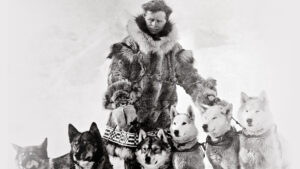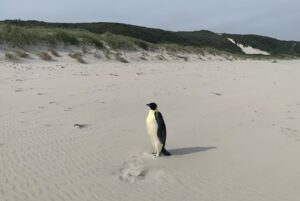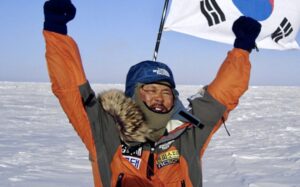Japanese explorer and rickshaw driver Masatatsu Abe hopes to pay tribute to Nobu Shirase’s 1911 Antarctic route by continuing from his endpoint to the South Pole.
In 2019, Japanese explorer and part-time rickshaw driver Masatatsu Abe “got absolutely smashed by the snow” on his way to the South Pole.
It was a grueling 55-day journey from the Messner Start, but he coped admirably in tough conditions. Now, after a one-year COVID delay, he hopes to return to Antarctica.
Abe has set his sights on retracing the steps of Japan’s most famous Antarctic explorer, Nobu Shirase. The same year that Amundsen and Scott raced for the South Pole, Shirase set out on an Antarctic expedition of his own.
Shirase’s expedition
It seemed doomed from the start. By the time he reached New Zealand in February 1911 (very late in the season), half his sled dogs were already dead. Local reporters were dismissive of his “strange” supplies — rice and pickles rather than high-energy meat and lard. They were equally skeptical of his boat, a small three-masted craft just one-third of the size of Scott’s Terra Nova.
But despite a shoestring budget and a fragile-looking boat, Shirase made it to Antarctica. With a small team, he ventured further than 80 degrees south. Eventually, they ran low on supplies, stuck a Japanese flag in the ground, and turned around. Shirase may not have made the Pole, but he had proved himself a hardy explorer.
Abe’s expedition loosely follows in those 100-year-old footprints. He plans to set out from 80°S, 156°W on the Ross Ice Shelf — Shirase’s endpoint. Then Abe intends to go all the way to the South Pole, covering the 1,200km in less than 65 days.

Abe’s projected route to the South Pole.
Abe’s 2019 solo expedition was unexpectedly tough. That season, soft snow derailed two speed record attempts and prematurely ended other expeditions. Near the end of Abe’s journey, low on food, he had to make a difficult decision. He could pick up a supply cache but lose his unsupported status, or try to ration his way to the Pole. In the end, he picked up the supply cache to ensure he made his target. “My main goal is the Shirase Route next year, so it’s important to demonstrate to ALE [Antarctic Logistics & Expeditions] that I can complete an expedition in Antarctica. Nothing happens in Antarctica without their clearance,” he said at the time.

Abe took on tough conditions in 2019. Here, he takes a break during a whiteout. Photo: Masatatsu Abe
Even harder this time
Though delayed, his foresight has paid off. But Abe is conscious that his main goal is a more serious undertaking. “The distance and the number of days will increase, and most importantly, I’ll have to cross the Trans-Antarctic Mountains, which will be my biggest challenge,” Abe told ExplorersWeb.
His 150kg sled is heavy enough without any extras, so there will be no space for his 2019 companion, a three-kilo robot dog that must surely have been a South Pole first. “I don’t think there will be room for humor [this year],” he said. “Robots are heavy!”

Abe and his robot dog at the South Pole in 2019. Photo: Masatatsu Abe
Abe has been training hard, but COVID has disrupted his schedule. He had intended to cross Greenland this spring. Instead, he had to make do pulling tires, going to the gym, climbing, and trail running in Japan.
Shirase returned from Antarctica to some fanfare but found himself in significant debt. Like Shirase, Abe does not seem like your typical Antarctic explorer. I asked how he was financing his own Antarctic epic. “The main thing is to get funding from sponsors. That, along with personal supporters, and income from speaking engagements, is how I got almost all of my budget,” he explained.

Abe has had to make do training in Japan. Here, he pitches his tent on the edge of town earlier this year. Photo: Masatatsu Abe






